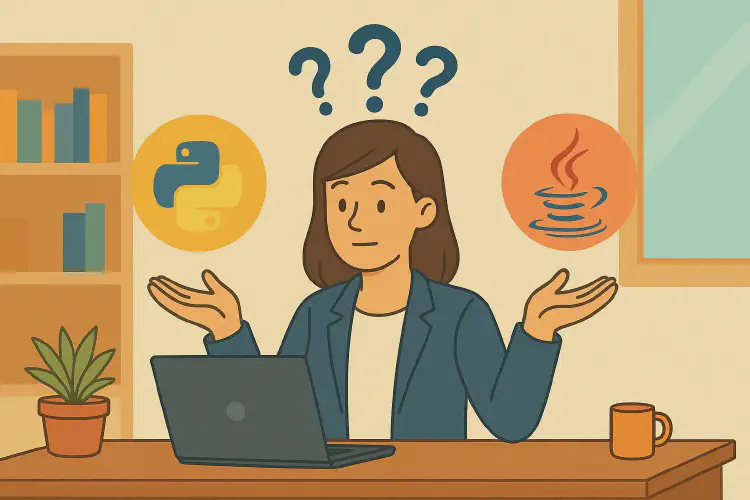Python Developer vs Java Developer: The Best Path for Beginners
Explore and compare these two career paths, their versatility, demand, and the key factors to help you choose the right route for you.
- | 5 min read

Have you ever wondered which programming path makes the most sense for your career: Python or Java? Both have been around for decades, power major companies, and promise solid job opportunities. But they’re not the same, and the choice you make now can shape your first steps as a developer.
Let’s break down these two career paths, compare the market demand, learning curve, and versatility, and give you the insights you need to make a smart decision.
Popularity and Job Market Demand
Have you noticed how Python is everywhere these days? From AI startups to finance, even in universities teaching data science, it’s popping up constantly. That’s no coincidence. Python’s readability, flexibility, and cross-industry adoption have made it one of the most popular and fastest-growing languages in the world. Job postings requiring Python skills are climbing rapidly, and demand shows no signs of slowing down.
Java, of course, holds a strong and respected position in the market as well. It’s the backbone of many enterprise systems, powers Android apps, and keeps massive backend infrastructures running smoothly. Its demand remains steady and reliable, particularly within established companies that value consistency and long-term stability.
So, if you’re wondering which language gives you broader opportunities today, the reality is that Python opens more doors across multiple industries, while Java continues to secure its place in stable, large-scale enterprise environments.
Learning Curve and Beginner-Friendliness
Let’s be honest — starting out in programming can be intimidating. So, which path gets you coding faster and easier?
Python is famously beginner-friendly. Its syntax is clean, almost like reading English. You can get a functional script running in a few lines. That quick feedback loop keeps learning fun, and it helps you stay motivated when building real projects. On top of that, Python’s welcoming and collaborative community is full of resources for beginners — libraries, tutorials, and ready-made solutions make it easier to solve problems and learn as you go.
Java, on the other hand, is more structured. It’s precise and verbose, which is great for large systems, but beginners often hit a steep learning curve. You’ll spend more time wrestling with syntax before your code actually works. Its community, while highly experienced and focused on enterprise-level projects, provides extensive guidance and documentation, though some frameworks can feel overwhelming for beginners.
In other words, Python lets you see results faster and in a much easier way, which is why so many newcomers start here, and why many experts suggest it as a smart first choice.
Versatility and Use Cases
Versatility — here’s where Python really shines. Web development? Check. Data analysis? Absolutely. Machine learning? You bet. Automation, cloud computing, IoT? Also covered. Frameworks like Django and Flask make building apps straightforward, and libraries like Pandas and TensorFlow let you explore data and AI projects with ease.
Java excels in structured, performance-critical systems: enterprise software, banking, and Android apps. But outside those areas, its use is narrower. Python’s flexibility means you can experiment, switch roles, or explore entirely new fields without learning a completely different language.
Choosing the Right Path for You

Ultimately, the choice between Python and Java depends on your career goals, learning preferences, and the types of projects you want to work on. These are some of the key considerations:
Learning Curve: If you’re new to coding, Python has a clear advantage. Its simple, readable syntax allows you to write working code quickly, which helps you build confidence and momentum as you learn. Java is more structured and verbose, which gives you a solid technical foundation but can feel challenging when you’re just starting out.
Project Type: Think about the kind of projects you want to work on. Python excels in data-heavy tasks, AI, machine learning, automation, and quick scripting. Java is often preferred for performance-critical applications, large-scale enterprise systems, and Android development.
Performance Needs: If raw execution speed is critical, Java generally outperforms Python. That’s why it’s still widely used in enterprise and mobile applications where efficiency is essential.
Ecosystem and Libraries: Both languages have rich ecosystems and extensive libraries to support almost any task. Python’s ecosystem, though, often makes experimentation and prototyping faster, while Java’s frameworks shine in large, complex, and long-lived projects.
Salary and growth: Both Python and Java developers earn competitive salaries and experience smooth career growth. Python’s growing role across fields often brings slightly higher pay in emerging markets, along with flexible career paths that span multiple disciplines. Java developers also enjoy stability and growth, especially in enterprise settings. Career progression is often structured, moving from backend developer to senior developer or software architect. It’s solid and more linear.
Takeaways with Linero Tech
In the end, the right path depends on your goals. If you want to start coding quickly, explore multiple industries, and stay flexible across emerging tech fields, Python offers a gentle entry with broad opportunities. If your focus is structured, performance-focused applications within enterprise systems or mobile development, Java provides a reliable, well-established path.
If Python is your choice, Linero Tech has your back
Our beginner-friendly course will prepare you for the tech career you want to build. You don’t need any prior programming experience — just curiosity, commitment, and the drive to grow.
Here’s what you’ll get:
Flexible Scheduling: Learn at your own pace. The course is designed to teach you Python fundamentals effectively in 12 weeks, but you’ll have 16 weeks of access.
Expert Guidance: Get direct mentorship from Humberto Linero, an experienced developer and teacher.
Practical Experience: Tackle 197 coding challenges designed to help you build real coding “muscle memory.”
Ready to learn Python the right way — from day one?
👉 Discover our tech training programs
👉 See student reviews and success stories
